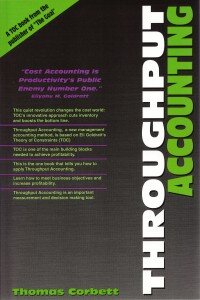People in the Theory of Constraints community have been publishing books in the field since Goldratt's The Goal came out in the mid-1980's. I like to keep up with the current publications, but occasionally I will go back to re-read an older book or pick up something I haven't read yet. That is the topic for today.
Thomas Corbett's Throughput Accounting is a slim volume published in 1998. My wife joked that it was strange to see me reading a "boring accounting book," since she was the one who studied business in college, not me. I must admit that it was somewhat dry - it's more of a textbook than a business novel that seems to be popular in the business press (and TOC press in particular). There are a bunch of good nuggets, though.
The short description of the book is that it provides the basics of using Throughput Accounting for making management decisions. There are sample worksheets, sample calculations, and sample reports. All very useful in reinforcing what I have learned and seen elsewhere in thinking about decision-making from a Theory of Constraints perspective. In fact, there was a lot of material that I skimmed because it was very familiar from the TOC Insights into Finance and Measurements or The Race or workshops I have done.
A question I have on reading the book is whether it has had an impact on accounting or on people who do accounting. Or is a useful book for people who are already doing Theory of Constraints work and need some basic guidance on setting up throughput-based reports and decision-making models.
One element that I particularly liked in the book was the statement that throughput accounting is a reasonable approach to supporting continuous improvement. Or more emphatically that cost accounting is an approach that is antithetical to continuous improvement. The logic goes something like this: Continuous improvement requires ongoing improvements for the organization. Cost accounting's primary focus is on cost - driving costs out of the system. However, there is a limit to how much cost can be removed - it can only go down to zero (when the company goes out of business). How can an organization continually improve down the cost path, when there is a limit to how much can be done? Even more, how can an organization expect ongoing collaborative input of its employees, when the biggest cost lever that is seen is the payroll cost of those very employees.
Throughput accounting, on the other hand, is focused on the goal of the system under study: creating more of what the system wants. This is throughput. Work on ever-increasing throughput of the organization. This is continuous improvement. And throughput accounting helps people make decisions with a relatively simple set of calculations.
And this focus on throughput at the system level brings another key point that Corbett makes - and that is made through much of the Theory of Constraints literature: Management need to focus on the few things that will improve the system - and they need tools to help them make decisions for the good of the system, not for the good of their pocketbook or their department. (And just maybe they need tools that ensure alignment between the system and these more local elements.)
Throughout the book the practice of throughput accounting is compared to cost accounting - cost accounting doesn't come out looking very good. The principle reason for this - stated over and over and argued from several directions - is that cost accounting requires cost allocations, and it operates under the assumption that the system under examination can be broken down into elements, those elements optimized, and the whole will be optimized as a result. This runs counter to what most people in systems thinking believe and understand.
And to help describe the difference in mindsets, a footnote at the end of the book has this fun analogy:
The pessimist thinks the glass is half empty. The optimist thinks the glass is half full. The cost accountant thinks you have twice as much glass as you need. The throughput accountant thinks you have room for twice as much stuff.
And if you are still reading and wondering about cost accounting, have a look at this story on Rudi Burkhardt's website, Funny story about Activity Based Costing, which is apparently from the 1960's.
